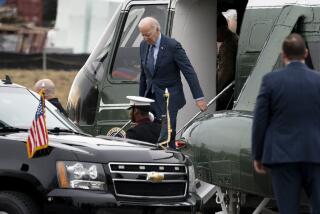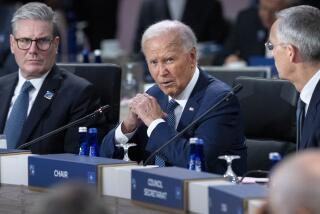Bush May Require Electric Procedure : Presidency: Anesthetized condition would entail a shift of powers to Quayle. Irregular heartbeat continues.
- Share via
WASHINGTON — If President Bush’s heart continues to respond inadequately to medication, doctors may attempt this morning to shock it into a proper pace and rhythm--a procedure that would entail at least a brief transfer of power to Vice President Dan Quayle.
“We’re hopeful the medicine will do the job,” White House Press Secretary Marlin Fitzwater said Sunday night. Otherwise, doctors will consider a procedure known as cardioversion, in which “a single application of direct electrical current to the heart” is used to break the chaotic pattern known as atrial fibrillation and return the heart to a normal rhythm as it pumps blood through the body.
He said the procedure would require the administration of a general anesthetic for “a relatively short period of time, perhaps only a couple of minutes.”
However, medical experts said that the President likely would be incapacitated longer than that, since the anesthetic normally takes several hours to wear off. They also noted that the shock treatment carries a very low risk--a risk that Fitzwater called “minimal.”
The White House spokesman said that legal papers had been updated to carry out the temporary transfer of powers to Quayle.
“During the short time that the President would be under anesthesia, the vice president would be acting President under the 25th Amendment,” Fitzwater said.
The 25th Amendment to the Constitution--last invoked when then-President Ronald Reagan underwent surgery for colon cancer--makes provisions for a vice president to assume the authority of President when the chief executive is incapacitated.
Quayle discussed the possible development with Bush on the telephone. “He is well aware of the President’s situation,” Fitzwater said.
Bush spent the day in his two-room suite at Bethesda Naval Medical Center while doctors added a second drug to the regimen that they had prescribed Saturday evening when he arrived there by helicopter after suffering fatigue while jogging at Camp David.
Bush appeared at the window of his top-floor quarters in the four-story building Sunday, smiling and appearing cheerful. He had spent the day “lying here,” he said, telling reporters gathered outside: “Don’t worry about me.”
Asked how he was feeling, he pointed to his heart and said: “It’s a question of getting back to normal.”
Asked if his irregular heart rhythm continued he responded: “Yes, can’t you hear it?”
Fitzwater said that, although there were some indications the President’s heart was responding positively to the medications, the normal rhythm had not been restored. He said that Bush was wearing a heart monitor to allow doctors to keep track of the heartbeat at all times.
The medications are digoxin and procainamide, which was added to the original digoxin regimen. Both drugs are standard treatments for the condition.
Digoxin is a form of digitalis, an extract from the foxglove plant that has been used by doctors for 200 years to slow down rapid heart rhythms.
Side effects can include nausea and vision disturbances if higher than necessary doses are used. But once the proper level of medication is achieved, it can be used safely for long periods.
Procainamide suppresses electrical impulses within the heart that contribute to the development of abnormal heart rhythms. It sometimes can cause rhythm disorders worse than the conditions it is being used to treat and also can lead to inflammation of such organs as the lungs and the sac around the heart.
Fitzwater said that the President’s medical team met from 4 p.m. to 6 p.m. Sunday to review his condition and that it would meet early this morning, possibly as early as 5 a.m., to determine whether the medication is working. If not, the doctors will discuss using the electrical pulse procedure.
Cardiologists differ on how long they would wait for a second medication to work before suggesting cardioversion. Some would only wait a day. Others would wait a week or more. Most patients who require cardioversion do well and many remain free of the abnormal heart rhythm in the long term. About one-quarter of atrial fibrillation patients with conditions similar to Bush’s fail to respond to medications and require cardioversion.
Cardioversion takes about 15 minutes. It is usually performed in a coronary care unit or a cardiac catheterization laboratory.
The patient is typically placed under general anesthesia with a short-acting barbiturate or other sedative that is administered through a vein. The patient breathes oxygen through a mask.
Cardiologists then administer an electrical shock to the heart, transmitted through paddles placed on the chest. If one shock doesn’t work, more powerful shocks are administered.
If cardioversion becomes necessary for Bush, “I would be very surprised if that did not convert him to a normal rhythm,” said Dr. William G. Stevenson, a cardiologist at the UCLA Medical Center in Los Angeles. If the procedure was successful, Bush likely would remain on heart medications for weeks or longer to prevent the condition from recurring, he added.
According to Stevenson, one of the advantages of performing cardioversion sooner rather than later is to avoid the need to administer drugs, such as Coumadin, to thin the blood before the procedure.
People with long-standing atrial fibrillation are at increased risk of forming blood clots in their heart. These blood clots sometimes travel through the circulatory system to the brain and cause strokes. But the increased risk of stroke for patients with isolated atrial fibrillation, such as Bush, is small, physicians said.
In disclosing the possible courses of Bush’s treatment, Fitzwater said: “We want to assure the American people that the President is in a healthy condition. He has not suffered a heart attack. He has not suffered heart muscle damage.”
First Lady Barbara Bush spent the day at the President’s side in the high-security VIP suite, but returned to the White House at nightfall. An aide said that she intends to stick to her plan to visit Stuart, Fla., today to attend a literacy program.
“A doctor I am not, but he looks fabulous, feels well. He’s fine,” she said Sunday morning after spending the night in the hospital with the President, whose 67th birthday is June 12.
As is often the case when a President is ill, the White House went out of its way to project an air of business as usual, announcing that Bush had spoken with Quayle and National Security Adviser Brent Scowcroft, and with several Cabinet secretaries, in what were described as personal calls.
Quayle Press Secretary David Beckwith said that the vice president spent a quiet day at his home, reading newspapers, taking his three children to church, playing catch with 14-year-old son Ben and playing two sets of tennis with Jack Kemp, secretary of housing and urban development. Later he had pizza for dinner with his children. Mrs. Quayle was out of town on what Beckwith said was a personal trip.
Atrial fibrillation occurs in about 4% of people over age 60. In a patient suffering from the disorder, electrical activity in the heart is “continuous and chaotic--out of control,” said Dr. George Bren, a cardiologist who is associate clinical professor of medicine and emergency medicine at George Washington University Medical Center.
Each heartbeat is triggered by an electrical wave that starts in the right atrium, one of four chambers of the heart. The wave then travels to the left atrium and to the two ventricles, the other chambers. The electrical pulse and the beat occur in “discrete intervals,” he said.
When atrial fibrillation occurs, he said, “the atria are going continuously and ineffectively,” at a random pattern.
Bren said that the consequences of the condition are rarely, if ever, life-threatening. However, if the condition persists for several days it can sometimes result in blood clots that can go to the brain, causing a stroke.
Fitzwater said that Bush spent “a relatively active day.” In addition to meeting with White House Chief of Staff John H. Sununu and Scowcroft, who were said to have reviewed policy matters and to have delivered a national security briefing, Bush was visited by two of his five children, Marvin Bush and Dorothy LeBlond, and by two of his grandchildren, Sam and Ellie LeBlond.
The medical team was expanded on Sunday, to include Dr. Bruce K. Lloyd, a U.S. Navy captain who is chief of cardiology at the naval hospital, and Dr. Allan Ross, chief of cardiology at George Washington University Medical Center. Lloyd was directing the President’s care, and Ross was brought in as a consultant. The White House said that Dr. Burton Lee, the President’s personal physician, was supervising the team.
Officials, beginning with Bush, went out of their way to emphasize that they anticipated no long-term impact on the President’s health from the episode.
Asked if he plans to keep jogging after he is released from the hospital, Bush said: “Yes, the doctor said that.” Indeed, doctors have said that the condition is not likely to have been brought on by the jogging he was doing when it struck.
In discussing the possible transfer of power, Fitzwater said that shortly after Bush took office, he sought to establish a procedure under which the 25th Amendment could be put into effect in an orderly, efficient manner.
The spokesman said that letters activating the transfer of power were prepared and are carried at all times by a military aide in the satchel, known as the “football,” that is said to also contain the codes needed to launch nuclear weapons.
The letters, Fitzwater said, “can be updated to fit any situation,” and that step had already been taken.
Times medical writer Robert Steinbrook contributed to this story.
More to Read
Get the L.A. Times Politics newsletter
Deeply reported insights into legislation, politics and policy from Sacramento, Washington and beyond. In your inbox twice per week.
You may occasionally receive promotional content from the Los Angeles Times.










